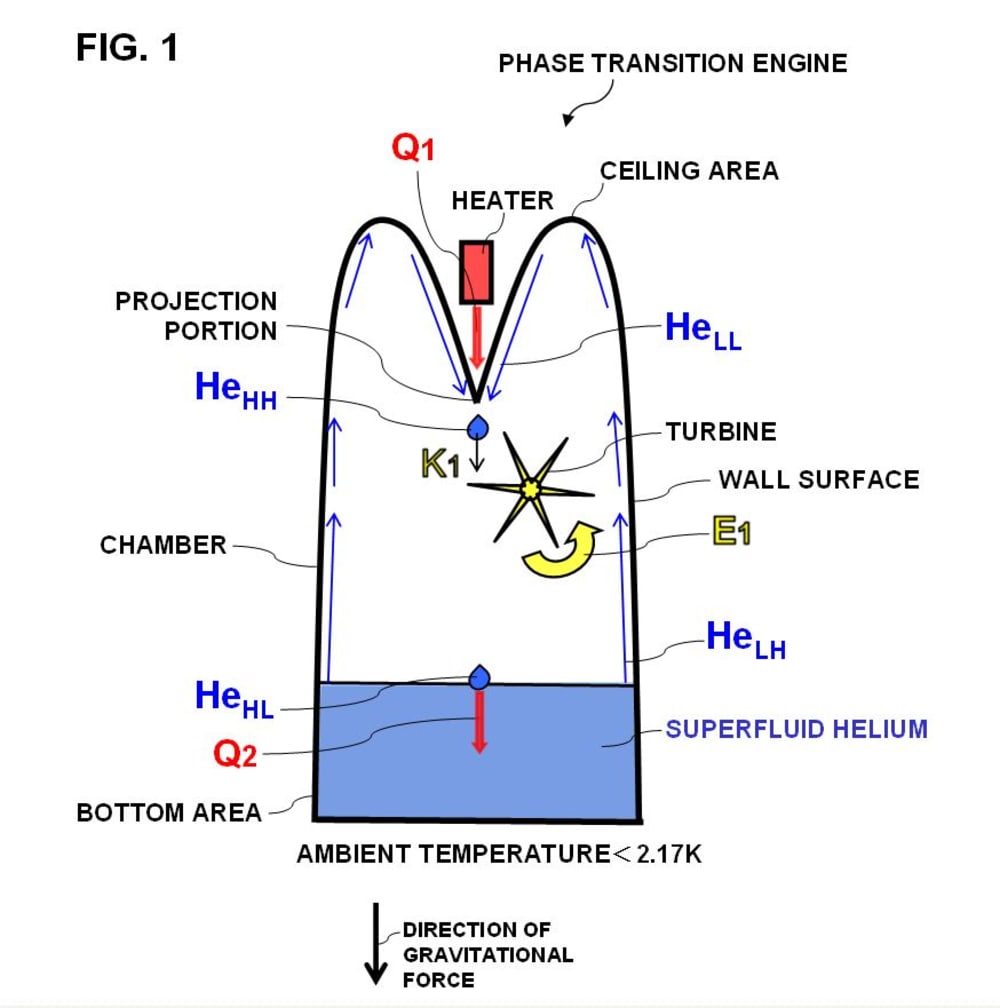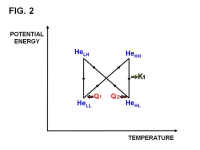This technology provides solutions to current energy problems and can reduce consumption of natural resources.
As an example of the phase transition, there is a phase transition between superfluid state and normal-fluid state of liquid helium. Figure 1 shows the phase transition engine to get energy using the superfluid phase transition. Figure 2 shows the potential energy diagram explaining input and output energy of liquid helium. Vertical axis indicates potential energy of helium. Horizontal axis indicates temperature of helium.
Liquid helium becomes superfluid state at temperature below 2.17K. Temperature environment below 2.17K can be produced on the earth. Also, temperature environment below 2.17K occurs in natural world. For example, temperature of Boomerang Nebula is about 1K. Under such environments, the superfluid state is the normal situation. The phase transition engine operates in such low-temperature environments.
Liquid helium temperature of a bottom area of a chamber shown in Figure 1 is lower than 2.17K. This superfluid helium HeLH (Low-temperature and High-potential energy) climbs on a wall surface of the chamber. This phenomenon is referred to as "Film Flow". The superfluid helium reaches a projection portion of a ceiling area and the potential energy becomes low level. In order to preventing back-flow of liquid helium, a Super Leak (not shown) may be provided on the ceiling area.
A heater supplies thermal energy Q1 to the superfluid helium HeLL (Low-temperature and Low-potential energy), so the superfluid helium changes to normal-fluid helium. When superfluid helium changes to normal-fluid helium, an influence of van der Waals force between the helium and the projection portion becomes smaller than that of gravitational force. So, the potential energy of the helium becomes high level.
Then the normal-fluid helium HeHH (High-temperature and High-potential energy) falls from the projection portion. The potential energy is converted to kinetic energy K1. Part of the kinetic energy K1 may convert to rotational energy E1 by a turbine.
The normal-fluid helium reaching liquid surface of the bottom area becomes High-temperature and Low-potential energy helium HeHL. The superfluid helium stored in the bottom area receives thermal energy Q2 from the normal-fluid helium HeHL, so the helium temperature becomes lower than 2.17K and the normal-fluid helium changes to superfluid helium HeLH again. The superfluid helium HeLH climbs on the wall surface again.
Input Energy inputted to the helium is the thermal energy Q1. Output energies outputted from the helium are the thermal energy Q2 and the kinetic energy K1. Sum of Q2 and K1 is grater than Q1. This indicates “Breaking the Law of Conservation of Energy”. The Law of conservation of energy is dependent on Noether's theorem. According to the Noether's theorem, the symmetry must be established to satisfying the conservation law. In other words, if symmetry breaking occurs, the breaking of the conservation law also occurs. Spontaneous symmetry breaking occurs at phase transition. Namely, Breaking the Law of Conservation of Energy occurs at phase transition. Also, this phenomenon predicts the existences of unknown elementary particles and/or unknown energies.
Like this entry?
-
About the Entrant
- Name:Tomooki Seki
- Type of entry:individual
- Software used for this entry:Microsoft PowerPoint
- Patent status:pending





